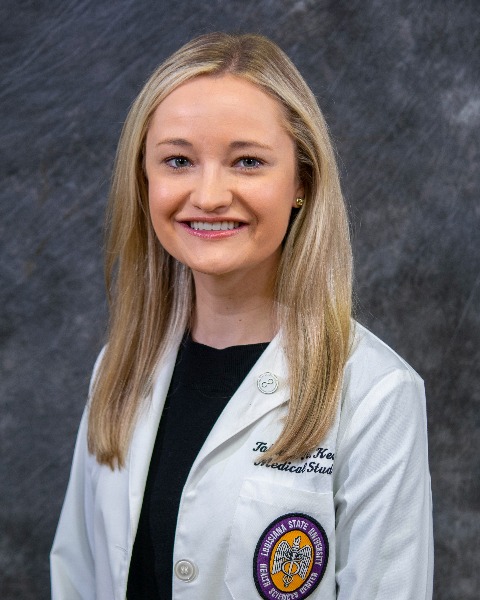Back
Palliative Care
Category: Abstract Submission
Palliative Care I
517 - The Implementation and Feasibility of a Patient/Family Satisfaction Survey at a Growing Pediatric Palliative Care Program
Friday, April 22, 2022
6:15 PM – 8:45 PM US MT
Poster Number: 517
Publication Number: 517.140
Publication Number: 517.140
Tabitha Kearns, Louisiana State University School of Medicine in New Orleans, New Orleans, LA, United States; Mallory Robichaux, Louisiana State University School of Medicine in New Orleans, New Orleans, LA, United States; Alexis Morvant, LSU health and Children’s Hospital New Orleans, New Orleans, LA, United States; Annie Vaden, Children's Hospital - New Orleans, New Orleans, LA, United States; Judy Zeringue, Children's Hospital, New Orleans, LA, United States; Ashley Kiefer Autrey, Children's Hospital New Orleans, New Orleans, LA, United States

Tabitha Kearns, B.S.
Medical Student
Louisiana State University School of Medicine in New Orleans
Thibodaux, Louisiana, United States
Presenting Author(s)
Background: Because many pediatric palliative care (PPC) programs remain in their infancy, it is important to develop sustainable and efficient standardized operating procedures to assess patient and family satisfaction with PPC services.
Objective: Growing programs can utilize these assessments to ensure they are meeting the needs of their patients and families, identify opportunities for improvement, and include the patient/family’s voice while advocating for ongoing program growth and development.
Design/Methods: An anonymous, online survey was developed using Pediatric Palliative Improvement Network’s Patient/ Family Satisfaction Survey tool and several program-specific questions. Eligibility criteria included: patient is followed by the PPC team; participants had at least one PPC interaction in the past six months, speak English or Spanish and are not in emotional distress; patient participants are at least 13 years of age and capable of completing the survey. Participants were contacted via three initial methods: in-person (if hospitalized and family present), email, or telephone. If unsuccessful after three in-person attempts, participants were contacted via email or telephone. If an email address was provided within the electronic medical record, participants were contacted by email and received a telephone call within 24 hours to confirm survey receipt and provide verbal introduction. If an email address was not available, participants were contacted via telephone to obtain an email address for survey distribution. Email reminders were sent to non-responders at one- and three-week intervals.
Results: Sixty-two eligible participants for 48 patients were identified. Three were excluded due to unsuccessful telephone contact. Survey response rate was 55.9% (Table 1). In-person contact was most effective (100%), followed by telephone (46.7%) and email (40%). Each communication attempt resulted in increased responses except the three-week email reminder.Conclusion(s): Participants were more likely to respond to the survey when approached in-person. If unable to approach participants in-person, programs may consider telephone and email. Participants who are likely to respond will do so following a one-week reminder. We hope these findings will guide PPC programs in implementing their own assessments to include the family’s voice in program development.
Tabitha Kearns CVT. Kearns CV.pdf
Objective: Growing programs can utilize these assessments to ensure they are meeting the needs of their patients and families, identify opportunities for improvement, and include the patient/family’s voice while advocating for ongoing program growth and development.
Design/Methods: An anonymous, online survey was developed using Pediatric Palliative Improvement Network’s Patient/ Family Satisfaction Survey tool and several program-specific questions. Eligibility criteria included: patient is followed by the PPC team; participants had at least one PPC interaction in the past six months, speak English or Spanish and are not in emotional distress; patient participants are at least 13 years of age and capable of completing the survey. Participants were contacted via three initial methods: in-person (if hospitalized and family present), email, or telephone. If unsuccessful after three in-person attempts, participants were contacted via email or telephone. If an email address was provided within the electronic medical record, participants were contacted by email and received a telephone call within 24 hours to confirm survey receipt and provide verbal introduction. If an email address was not available, participants were contacted via telephone to obtain an email address for survey distribution. Email reminders were sent to non-responders at one- and three-week intervals.
Results: Sixty-two eligible participants for 48 patients were identified. Three were excluded due to unsuccessful telephone contact. Survey response rate was 55.9% (Table 1). In-person contact was most effective (100%), followed by telephone (46.7%) and email (40%). Each communication attempt resulted in increased responses except the three-week email reminder.Conclusion(s): Participants were more likely to respond to the survey when approached in-person. If unable to approach participants in-person, programs may consider telephone and email. Participants who are likely to respond will do so following a one-week reminder. We hope these findings will guide PPC programs in implementing their own assessments to include the family’s voice in program development.
Tabitha Kearns CVT. Kearns CV.pdf
